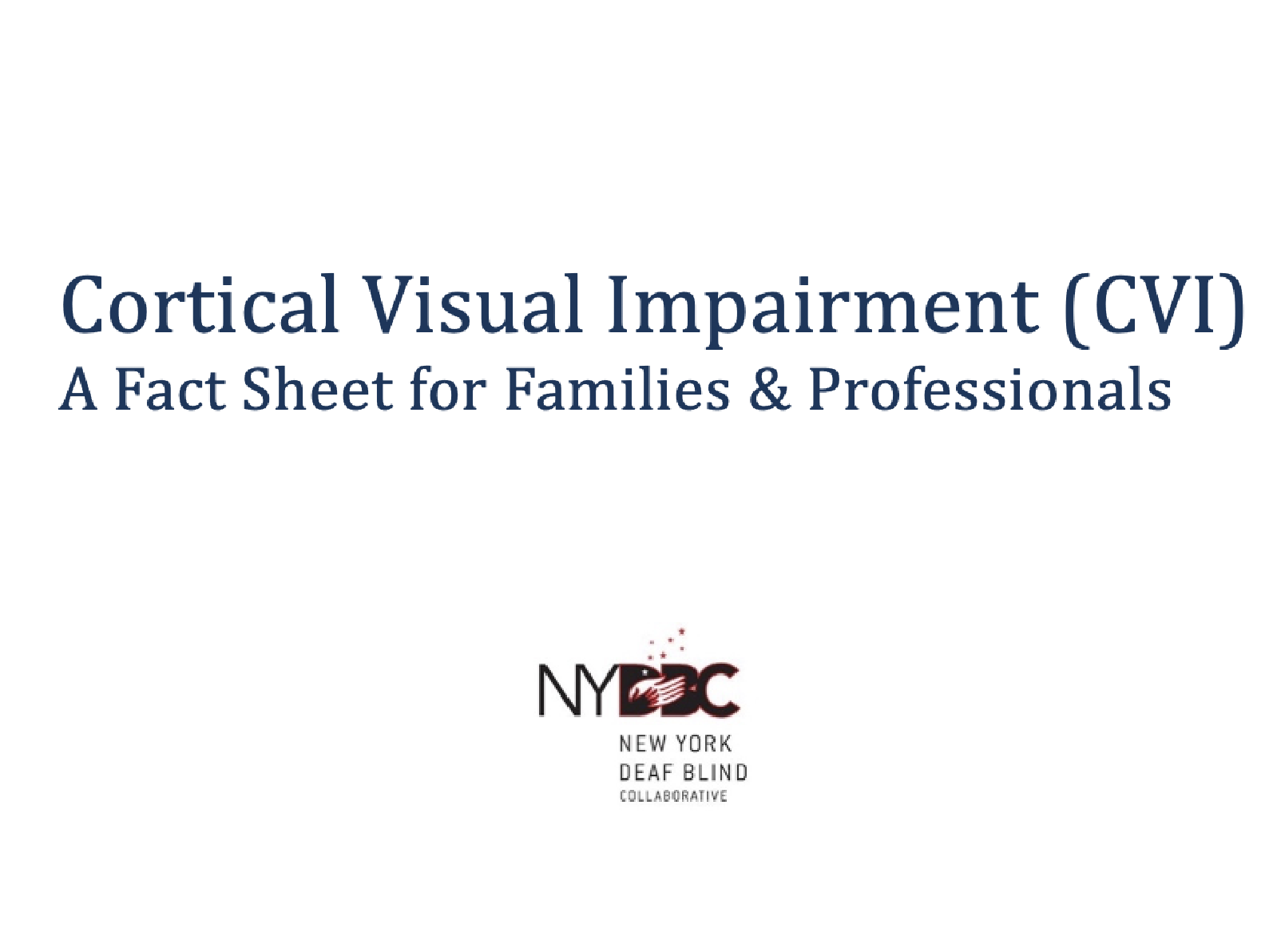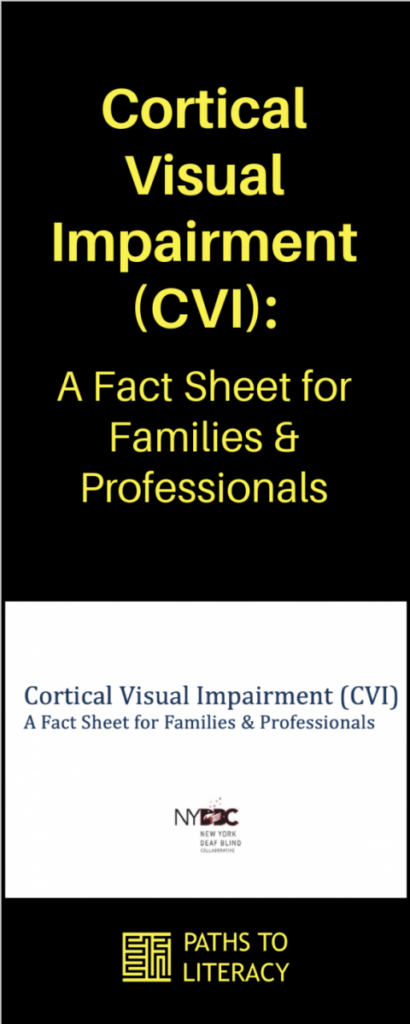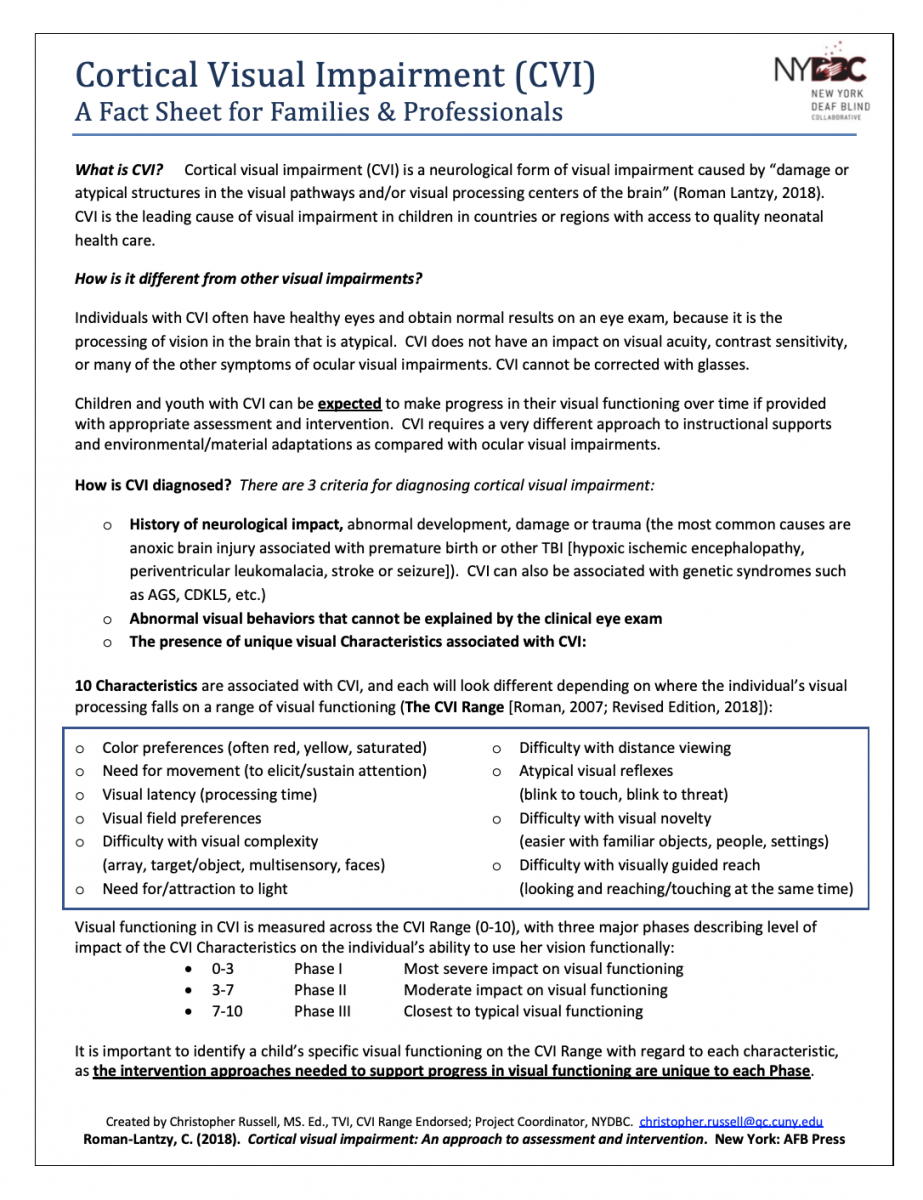
Cortical Visual Impairment (CVI): A Fact Sheet for Families & Professionals
This fact sheet on cortical visual impairment (CVI) is designed to provide quick information to families and professionals.
Published 2020, visit CVINow for the latest research
What is CVI?
Cortical visual impairment (CVI) is a neurological form of visual impairment caused by “damage or atypical structures in the visual pathways and/or visual processing centers of the brain” (Roman Lantzy, 2018). CVI is the leading cause of visual impairment in children in countries or regions with access to quality neonatal health care.
How is it different from other visual impairments?
Individuals with CVI often have healthy eyes and obtain normal results on an eye exam, because it is the processing of vision in the brain that is atypical. CVI does not have an impact on visual acuity, contrast sensitivity, or many of the other symptoms of ocular visual impairments. CVI cannot be corrected with glasses.
Children and youth with CVI can be expected to make progress in their visual functioning over time if provided with appropriate assessment and intervention. CVI requires a very different approach to instructional supports and environmental/material adaptations as compared with ocular visual impairments.
How is CVI diagnosed?
There are 3 criteria for diagnosing cortical visual impairment:
- History of neurological impact, abnormal development, damage or trauma (the most common causes are anoxic brain injury associated with premature birth or other Traumatic Brain Injury, such as hypoxic ischemic encephalopathy, periventricular leukomalacia, stroke or seizure). CVI can also be associated with genetic syndromes, such as AGS, CDKL5, etc.
- Abnormal visual behaviors that cannot be explained by the clinical eye exam
- The presence of unique visual Characteristics associated with CVI
10 Characteristics Associated with CVI
10 Characteristics are associated with CVI, and each will look different depending on where the individual’s visual processing falls on a range of visual functioning (The CVI Range [Roman, 2007; Revised Edition, 2018]):
- Color preferences (often red, yellow, saturated)
- Need for movement (to elicit/sustain attention)
- Visual latency (processing time)
- Visual field preferences
- Difficulty with visual complexity (array, target/object, multisensory, faces)
- Need for/attraction to light
- Difficulty with distance viewing
- Atypical visual reflexes (blink to touch, blink to threat)
- Difficulty with visual novelty (easier with familiar objects, people, settings)
- Difficulty with visually guided reach (looking and reaching/touching at the same time)
Visual functioning in CVI is measured across the CVI Range (0-10), with three major phases describing level of impact of the CVI Characteristics on the individual’s ability to use her vision functionally:
- 0-3 Phase I Most severe impact on visual functioning
- 3-7 Phase II Moderate impact on visual functioning
- 7-10 Phase III Closest to typical visual functioning
It is important to identify a child’s specific visual functioning on the CVI Range with regard to each characteristic, as the intervention approaches needed to support progress in visual functioning are unique to each Phase.
Frequently Asked Questions:
Who can diagnose CVI?
An ophthalmologist, neuro-ophthalmologist, optometrist, neurologist, or other clinical specialist.
The eye exam said “normal” or “unable to test” but I know that my child/student has atypical visual behaviors.
Make sure that the clinical specialist has knowledge of and ability to diagnose CVI before making the appointment. Clinical vision specialists who have expertise in the structure of the eyes may not necessarily be familiar with or able to diagnose CVI.
The functional vision assessment (FVA) did not address the unique characteristics of CVI.
You are entitled to educational assessment that is relevant to your child’s specific visual condition(s). You can ask for an assessment that addresses the unique visual implications of CVI, which is very different from other ocular forms of visual impairment.
Additional Resources
- Perkins School for the Blind’s E-Learning website resources for professionals and families development
- “Statement on Cortical Visual Impairment” (Roman, Baker-Nobles, Dutton, Evans Luiselli, Flener, Jan, Lantzy, Matsuba, Mayer, Newcomb, & Nielsen, 2008)
- Pediatric Cortical Visual Impairment Society family advocacy group with extensive resources on CVI
- General resources for ideas on CVI:
- Little Bear Sees family-oriented website and resources
- Georgia Sensory Assistance Project training resources and videos
- Kaleidescope: The Cortical Visual Impairment Podcast unique perspectives from families and professionals
- Texas School for the Blind & Visually Impaired training resources and videos
- Paths to Literacy resources and intervention ideas on CVI
- Salient Features Collaborative – a website collaboration by professionals to support children with CVI
- National family teleconference group for families of children/youth with CVI (hosted by Lighthouse Guild International). Register here or for more information, contact Judith Millman (judithmillman@aol.com)
- Professional development opportunities:
- Perkins E-Learning online classes on a variety of topics related to CVI


